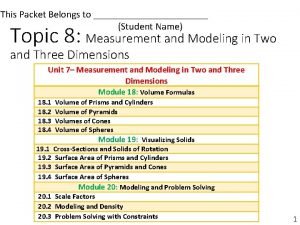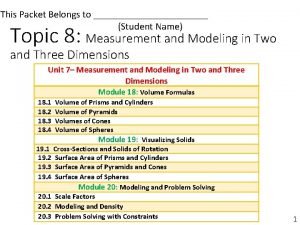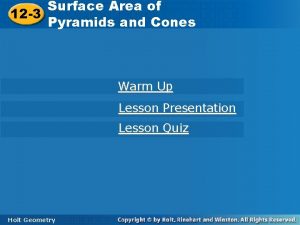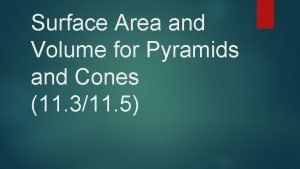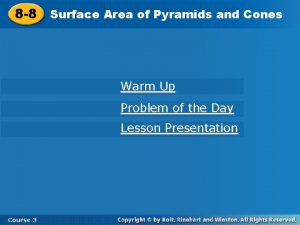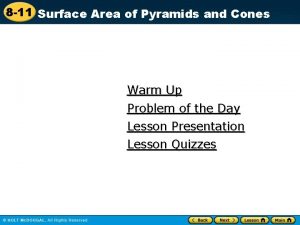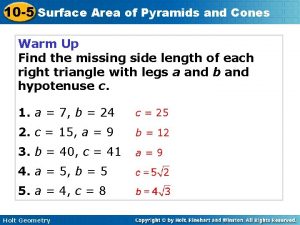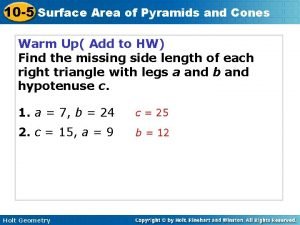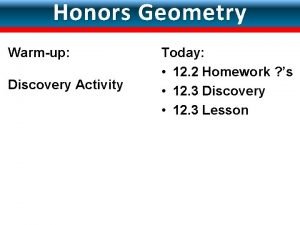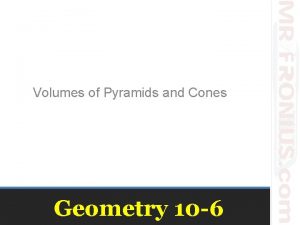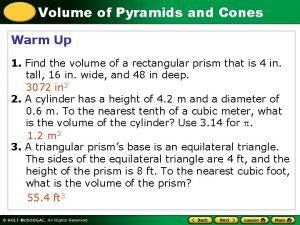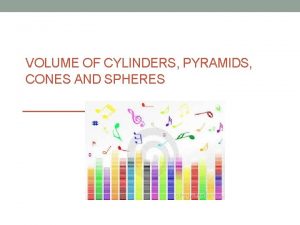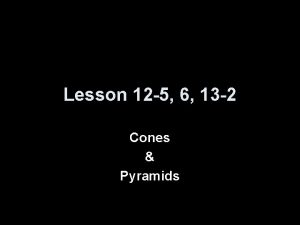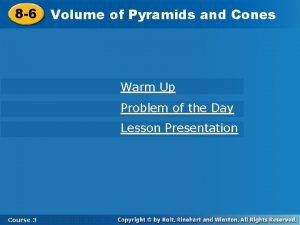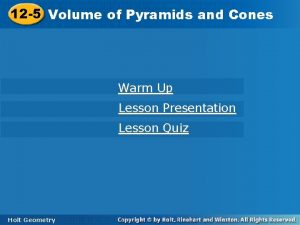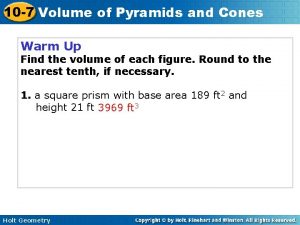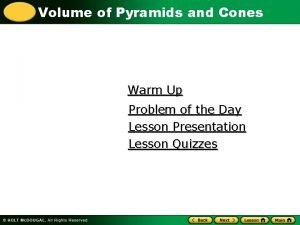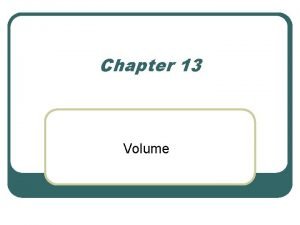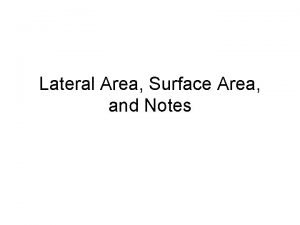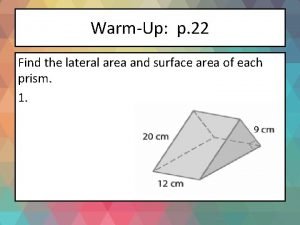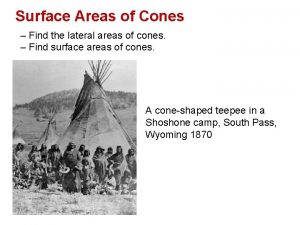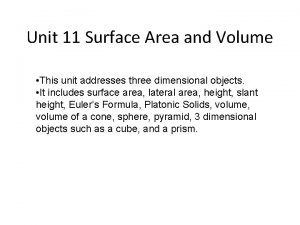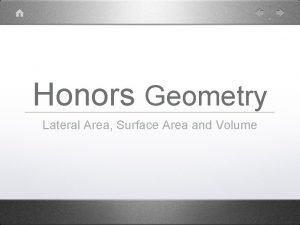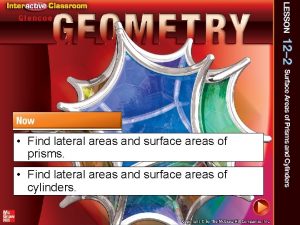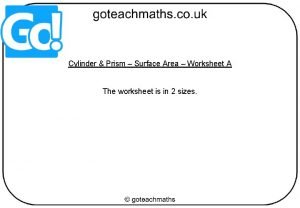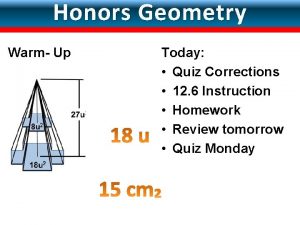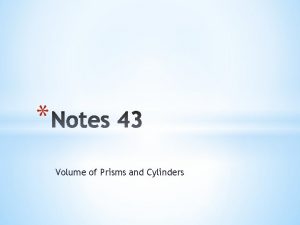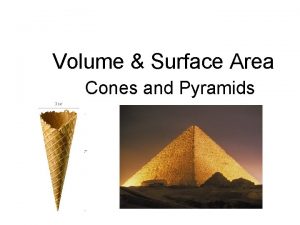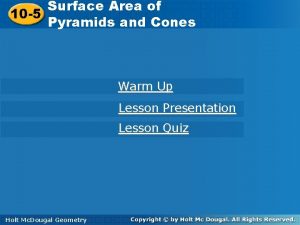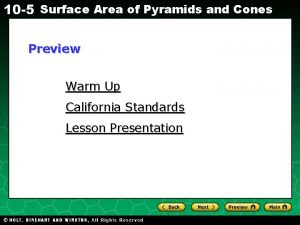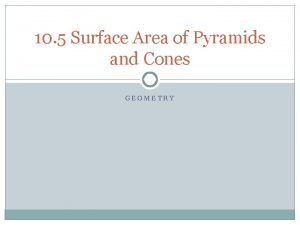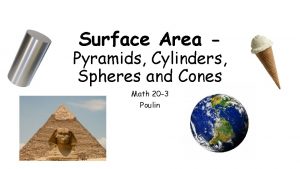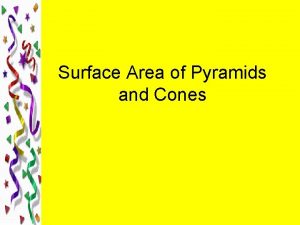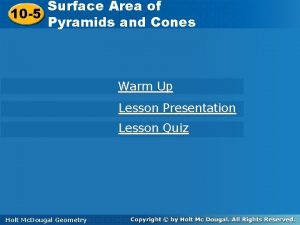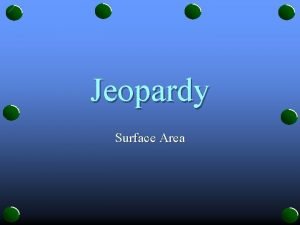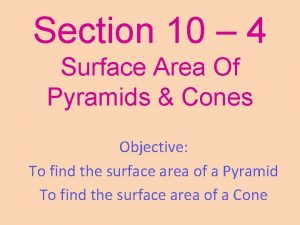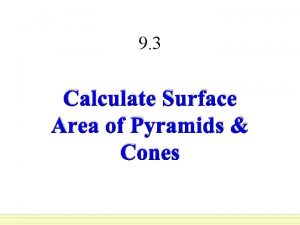Surface Area of Pyramids and Cones 10 5


































- Slides: 34

Surface Area of Pyramids and Cones 10 -5 Surface Area of Pyramids and Cones Warm Up Lesson Presentation Lesson Quiz Holt Geometry

10 -5 Surface Area of Pyramids and Cones Warm Up Find the missing side length of each right triangle with legs a and b and hypotenuse c. 1. a = 7, b = 24 c = 25 2. c = 15, a = 9 b = 12 3. b = 40, c = 41 a=9 4. a = 5, b = 5 5. a = 4, c = 8 Holt Geometry

10 -5 Surface Area of Pyramids and Cones Objectives Learn and apply the formula for the surface area of a pyramid. Learn and apply the formula for the surface area of a cone. Holt Geometry

10 -5 Surface Area of Pyramids and Cones Vocabulary vertex of a pyramid regular pyramid slant height of a regular pyramid altitude of a pyramid vertex of a cone axis of a cone right cone oblique cone slant height of a right cone altitude of a cone Holt Geometry

10 -5 Surface Area of Pyramids and Cones The vertex of a pyramid is the point opposite the base of the pyramid. The base of a regular pyramid is a regular polygon, and the lateral faces are congruent isosceles triangles. The slant height of a regular pyramid is the distance from the vertex to the midpoint of an edge of the base. The altitude of a pyramid is the perpendicular segment from the vertex to the plane of the base. Holt Geometry

10 -5 Surface Area of Pyramids and Cones The lateral faces of a regular pyramid can be arranged to cover half of a rectangle with a height equal to the slant height of the pyramid. The width of the rectangle is equal to the base perimeter of the pyramid. Holt Geometry

10 -5 Surface Area of Pyramids and Cones Holt Geometry

10 -5 Surface Area of Pyramids and Cones Example 1 A: Finding Lateral Area and Surface Area of Pyramids Find the lateral area and surface area of a regular square pyramid with base edge length 14 cm and slant height 25 cm. Round to the nearest tenth, if necessary. Lateral area of a regular pyramid P = 4(14) = 56 cm Surface area of a regular pyramid B = 142 = 196 cm 2 Holt Geometry

10 -5 Surface Area of Pyramids and Cones Example 1 B: Finding Lateral Area and Surface Area of Pyramids Find the lateral area and surface area of the regular pyramid. Step 1 Find the base perimeter and apothem. The base perimeter is 6(10) = 60 in. The apothem is Holt Geometry , so the base area is

10 -5 Surface Area of Pyramids and Cones Example 1 B Continued Find the lateral area and surface area of the regular pyramid. Step 2 Find the lateral area. Lateral area of a regular pyramid Substitute 60 for P and 16 for ℓ. Holt Geometry

10 -5 Surface Area of Pyramids and Cones Example 1 B Continued Find the lateral area and surface area of the regular pyramid. Step 3 Find the surface area. Surface area of a regular pyramid Substitute Holt Geometry for B.

10 -5 Surface Area of Pyramids and Cones Check It Out! Example 1 Find the lateral area and surface area of a regular triangular pyramid with base edge length 6 ft and slant height 10 ft. Step 1 Find the base perimeter and apothem. The base perimeter is 3(6) = 18 ft. The apothem is Holt Geometry so the base area is

10 -5 Surface Area of Pyramids and Cones Check It Out! Example 1 Continued Find the lateral area and surface area of a regular triangular pyramid with base edge length 6 ft and slant height 10 ft. Step 2 Find the lateral area. Lateral area of a regular pyramid Substitute 18 for P and 10 for ℓ. Holt Geometry

10 -5 Surface Area of Pyramids and Cones Check It Out! Example 1 Continued Find the lateral area and surface area of a regular triangular pyramid with base edge length 6 ft and slant height 10 ft. Step 3 Find the surface area. Surface area of a regular pyramid Substitute Holt Geometry for B.

10 -5 Surface Area of Pyramids and Cones The vertex of a cone is the point opposite the base. The axis of a cone is the segment with endpoints at the vertex and the center of the base. The axis of a right cone is perpendicular to the base. The axis of an oblique cone is not perpendicular to the base. Holt Geometry

10 -5 Surface Area of Pyramids and Cones The slant height of a right cone is the distance from the vertex of a right cone to a point on the edge of the base. The altitude of a cone is a perpendicular segment from the vertex of the cone to the plane of the base. Holt Geometry

10 -5 Surface Area of Pyramids and Cones Example 2 A: Finding Lateral Area and Surface Area of Right Cones Find the lateral area and surface area of a right cone with radius 9 cm and slant height 5 cm. L = rℓ Lateral area of a cone = (9)(5) = 45 cm 2 Substitute 9 for r and 5 for ℓ. S = rℓ + r 2 Surface area of a cone = 45 + (9)2 = 126 cm 2 Substitute 5 for ℓ and 9 for r. Holt Geometry

10 -5 Surface Area of Pyramids and Cones Example 2 B: Finding Lateral Area and Surface Area of Right Cones Find the lateral area and surface area of the cone. Use the Pythagorean Theorem to find ℓ. L = rℓ Lateral area of a right cone = (8)(17) Substitute 8 for r and 17 for ℓ. 2 = 136 in S = rℓ + r 2 = 136 + (8)2 = 200 in 2 Holt Geometry Surface area of a cone Substitute 8 for r and 17 for ℓ.

10 -5 Surface Area of Pyramids and Cones Check It Out! Example 2 Find the lateral area and surface area of the right cone. Use the Pythagorean Theorem to find ℓ. ℓ L = rℓ Lateral area of a right cone = (8)(10) Substitute 8 for r and 10 for ℓ. 2 = 80 cm S = rℓ + r 2 = 80 + (8)2 = 144 cm 2 Holt Geometry Surface area of a cone Substitute 8 for r and 10 for ℓ.

10 -5 Surface Area of Pyramids and Cones Example 3: Exploring Effects of Changing Dimensions The base edge length and slant height of the regular hexagonal pyramid are both divided by 5. Describe the effect on the surface area. Holt Geometry

10 -5 Surface Area of Pyramids and Cones Example 3 Continued 3 in. 2 in. original dimensions: 1 S = 2 Pℓ + B Holt Geometry base edge length and slant height divided by 5: 1 S = 2 Pℓ + B

10 -5 Surface Area of Pyramids and Cones Example 3 Continued 3 in. 2 in. original dimensions: base edge length and slant height divided by 5: Notice that . If the base edge length and slant height are divided by 5, the surface area is divided by 52, or 25. Holt Geometry

10 -5 Surface Area of Pyramids and Cones Check It Out! Example 3 The base edge length and slant height of the regular square pyramid are both multiplied by. Describe the effect on the surface area. Holt Geometry

10 -5 Surface Area of Pyramids and Cones Check It Out! Example 3 Continued 8 ft 10 ft original dimensions: 1 S = 2 Pℓ + B = 585 cm 2 multiplied by two-thirds: S= 1 Pℓ 2 +B = 260 cm 2 By multiplying the dimensions by two-thirds, the surface area was multiplied by. Holt Geometry

10 -5 Surface Area of Pyramids and Cones Example 4: Finding Surface Area of Composite Three. Dimensional Figures Find the surface area of the composite figure. Left-hand cone: The lateral area of the cone is L = rl = (6)(12) = 72 in 2. Right-hand cone: Using the Pythagorean Theorem, l = 10 in. The lateral area of the cone is L = rl = (6)(10) = 60 in 2. Holt Geometry

10 -5 Surface Area of Pyramids and Cones Example 4 Continued Find the surface area of the composite figure. Composite figure: S = (left cone lateral area) + (right cone lateral area) = 60 in 2 + 72 in 2 = 132 in 2 Holt Geometry

10 -5 Surface Area of Pyramids and Cones Check It Out! Example 4 Find the surface area of the composite figure. Surface Area of Cube without the top side: S = 4 wh + B S = 4(2)(2) + (2)(2) = 20 yd 2 Holt Geometry

10 -5 Surface Area of Pyramids and Cones Check It Out! Example 4 Continued Surface Area of Pyramid without base: Surface Area of Composite: Surface of Composite = SA of Cube + SA of Pyramid Holt Geometry

10 -5 Surface Area of Pyramids and Cones Example 5: Manufacturing Application If the pattern shown is used to make a paper cup, what is the diameter of the cup? The radius of the large circle used to create the pattern is the slant height of the cone. The area of the pattern is the lateral area of the cone. The area of the pattern is also of the large circle, so Holt Geometry of the area

10 -5 Surface Area of Pyramids and Cones Example 5 Continued If the pattern shown is used to make a paper cup, what is the diameter of the cup? Substitute 4 for ℓ, the slant height of the cone and the radius of the large circle. r = 2 in. Solve for r. The diameter of the cone is 2(2) = 4 in. Holt Geometry

10 -5 Surface Area of Pyramids and Cones Check It Out! Example 5 What if…? If the radius of the large circle were 12 in. , what would be the radius of the cone? The radius of the large circle used to create the pattern is the slant height of the cone. The area of the pattern is the lateral area of the cone. The area of the pattern is also the large circle, so Holt Geometry of the area of

10 -5 Surface Area of Pyramids and Cones Check It Out! Example 5 Continued What if…? If the radius of the large circle were 12 in. , what would be the radius of the cone? Substitute 12 for ℓ, the slant height of the cone and the radius of the large circle. r = 9 in. Solve for r. The radius of the cone is 9 in. Holt Geometry

10 -5 Surface Area of Pyramids and Cones Lesson Quiz: Part I Find the lateral area and surface area of each figure. Round to the nearest tenth, if necessary. 1. a regular square pyramid with base edge length 9 ft and slant height 12 ft L = 216 ft 2; S = 297 ft 2 2. a regular triangular pyramid with base edge length 12 cm and slant height 10 cm L = 180 cm 2; S ≈ 242. 4 cm 2 Holt Geometry

10 -5 Surface Area of Pyramids and Cones Lesson Quiz: Part II 4. A right cone has radius 3 and slant height 5. The radius and slant height are both multiplied by. Describe the effect on the surface area. The surface area is multiplied by . 5. Find the surface area of the composite figure. Give your answer in terms of . S = 24 ft 2 Holt Geometry
 Lesson 19-3 surface area of pyramids and cones
Lesson 19-3 surface area of pyramids and cones Pyramid volume
Pyramid volume 11-3 surface areas of pyramids and cones
11-3 surface areas of pyramids and cones What is the formula for the surface area of a cone
What is the formula for the surface area of a cone 11-3 surface areas of pyramids and cones answer key
11-3 surface areas of pyramids and cones answer key Surface area of pyramids and cones
Surface area of pyramids and cones Surface area of pyramids and cones
Surface area of pyramids and cones Surface area of pyramids and cones
Surface area of pyramids and cones 10-5 surface area of pyramids and cones
10-5 surface area of pyramids and cones 12-3 skills practice surface areas of pyramids and cones
12-3 skills practice surface areas of pyramids and cones 12-3 surface areas of pyramids and cones answer key
12-3 surface areas of pyramids and cones answer key Wet curved surface area
Wet curved surface area Lsa of a triangular prism
Lsa of a triangular prism Practice 10-6 volumes of pyramids and cones
Practice 10-6 volumes of pyramids and cones 11-3 reteach volume of pyramids and cones
11-3 reteach volume of pyramids and cones Finding the volume of cylinders pyramids cones and spheres
Finding the volume of cylinders pyramids cones and spheres Lesson 12-5 volumes of pyramids and cones
Lesson 12-5 volumes of pyramids and cones Volume pyramids and cones worksheet
Volume pyramids and cones worksheet 12-5 volumes of pyramids and cones
12-5 volumes of pyramids and cones 11-3 skills practice volumes of pyramids and cones
11-3 skills practice volumes of pyramids and cones Volumes of pyramids and cones quiz
Volumes of pyramids and cones quiz 10-7 volume of pyramids and cones answer key
10-7 volume of pyramids and cones answer key Volume of pyramids and cones calculator
Volume of pyramids and cones calculator 13-3 volumes of spheres answers
13-3 volumes of spheres answers What is the lateral area
What is the lateral area Lateral edge
Lateral edge Altitude of cone
Altitude of cone Area vs surface area
Area vs surface area Latwral area
Latwral area Lateral area vs surface area
Lateral area vs surface area Find the lateral area of a hexagonal prism
Find the lateral area of a hexagonal prism Surface area and volume of cylinders and prisms worksheet
Surface area and volume of cylinders and prisms worksheet 12-6 surface areas and volumes of spheres
12-6 surface areas and volumes of spheres Find the volume of each figure
Find the volume of each figure Surface area and volume of prisms maze answer key
Surface area and volume of prisms maze answer key
